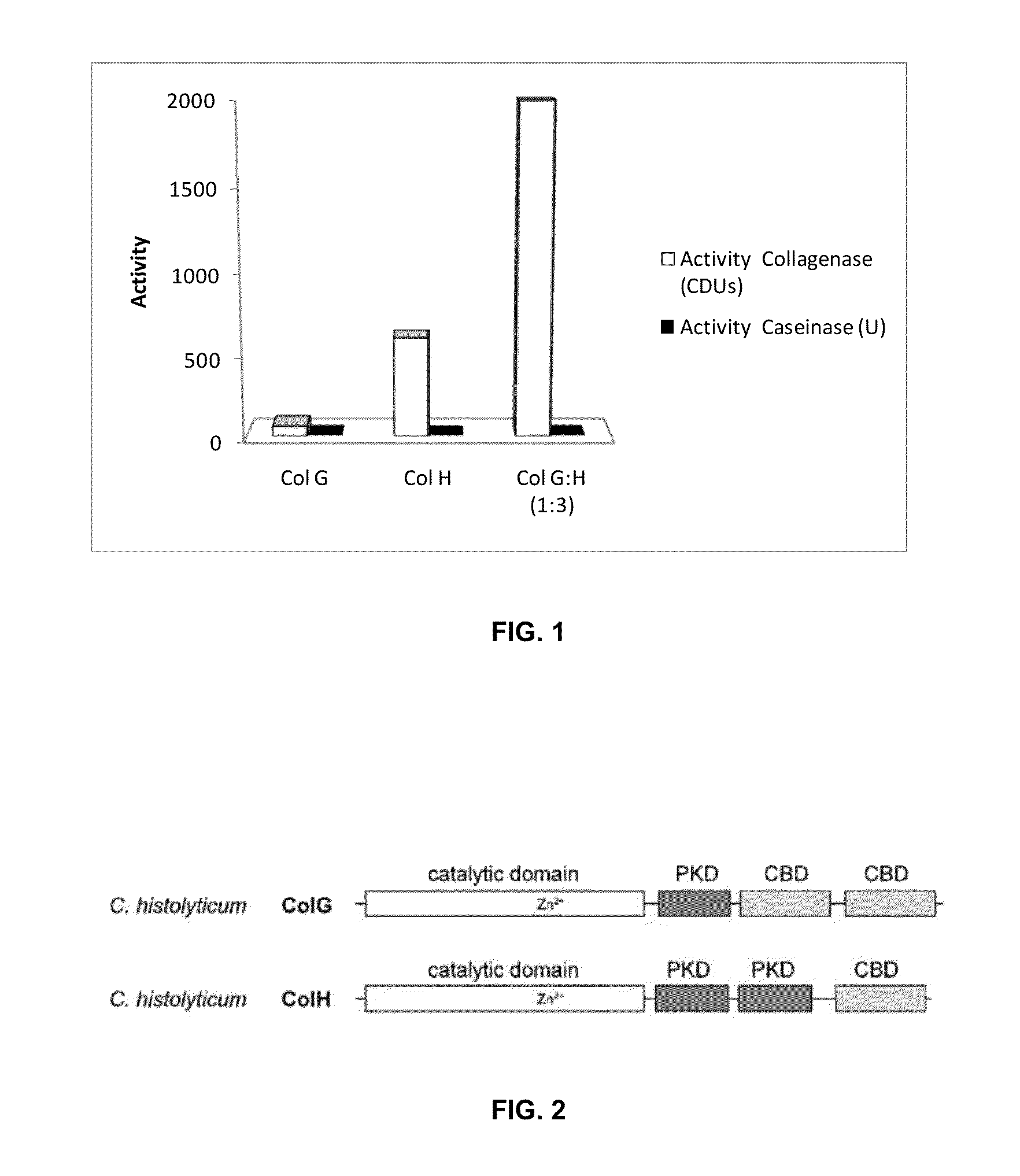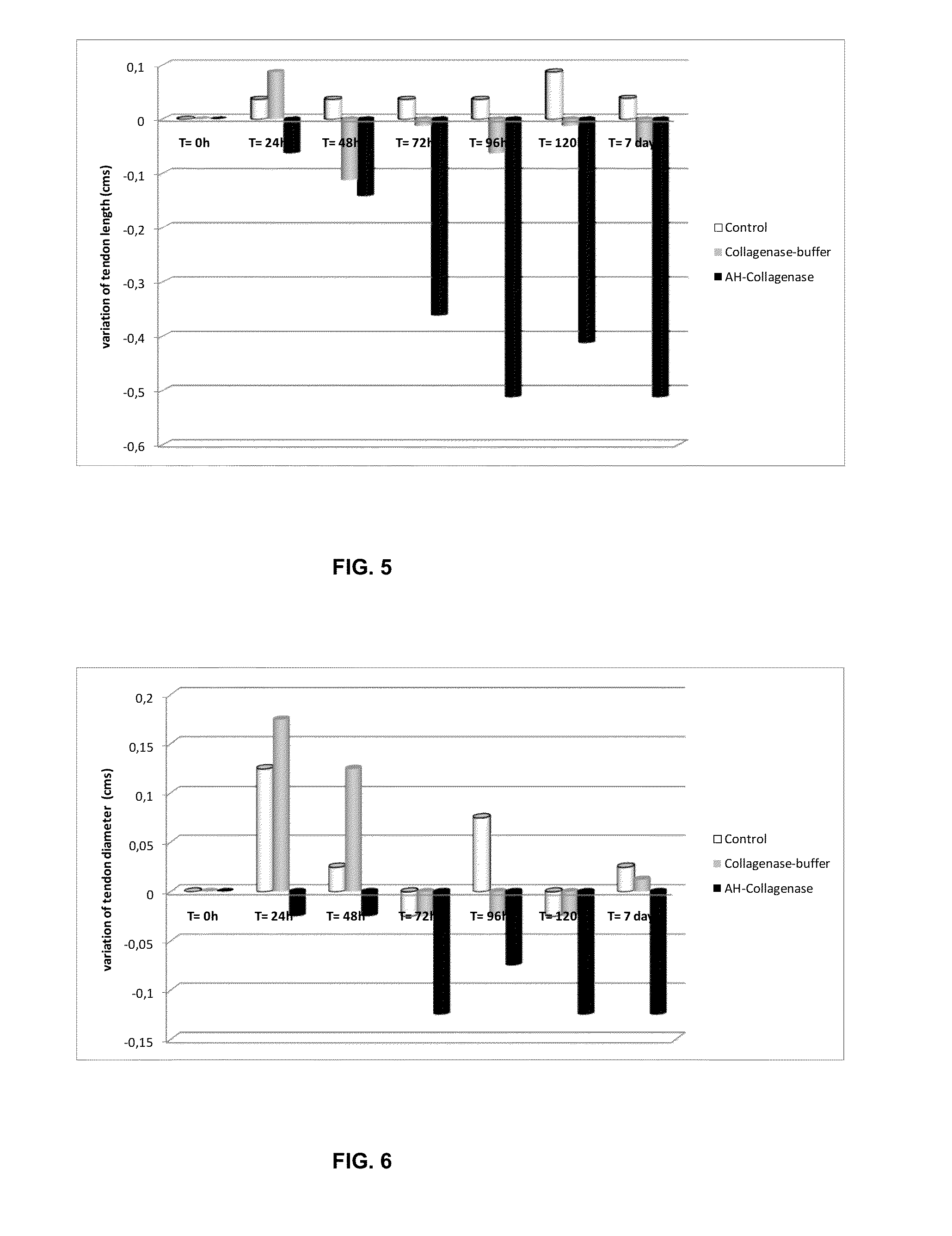Collagenase g and collagenase h compositions for the treatment of diseases involving alterations of collagen
a technology of collagen and composition, which is applied in the direction of biochemistry apparatus and processes, enzymes, non-active ingredients of pharmaceuticals, etc., can solve the problems of unbalance between synthesis and degradation of collagen, excessive collagen, and treatment limitations
- Summary
- Abstract
- Description
- Claims
- Application Information
AI Technical Summary
Benefits of technology
Problems solved by technology
Method used
Image
Examples
example 1
Preparation and Properties of Collagenases
[0114]Collagenase H and Collagenase G are metalloproteinases (class II) which can specifically degrade collagen helical regions, recognizing the Gly-Pro-X reason characteristic to the macromolecule. These proteins have a tail of 6 Histidines at its carboxyl terminus (Demina & Lysenko. Mikrobiologiia. 1996 May-June; 65(3):293-304).
[0115]Isoelectric point and molecular weight: Col.H: Ip 5.76; MW 112.98 kDa; Col.G: Ip 5.53; MW 114.8 Kda.
[0116]Purity: 99.9% Purification by nickel affinity columns, ion exchange and exclusion.
[0117]It is presented as lyophilized and sterile. Deionized sterile water is used for optimal reconstitution:
Stock Preparation
[0118]For the preparation Collagenase G / H 1:3, the lyophilized presentation contains 800 CDUs (approx. 0.3 mg). For administration it is recommended to resuspend the content of the vial in 1 ml sterile mQ water to obtain a solution of the enzyme 800 CDUs / ml in 20 mM Tris buffer pH 8.0. It is recommende...
example 2
Preparation of the Pharmaceutical Form of the Invention
[0121]Recombinant (rColG and rColH) Collagenase G (ColG or AUX-I) and Collagenase H (ColH or AUX-II), separately or combined, and more specifically in the ratio 1:3 formulated as a therapeutic gel, such as Hyaluronic acid. Hyaluronic acid is classified as a Medical Device and was produced by Novozymes Biopharma with a molecular weight of 850 kDa.
[0122]The density of the Hyaluronic acid should be sufficient so as to allow local treatment and the continuous and controlled release of the active ingredient, collagenases. The optimum density of the Hyaluronic acid gel 850 KDa with Collagenase is 1.5%, allowing a suitable consistency for the injection of collagen fibers, retaining the active ingredient locally and allowing the controlled release in the area of application.
[0123]Any other similar consistency gel made with hyaluronic acid is equivalent, using higher or lower molecular weights and concentrations of the same in aqueous so...
example 3
Ex Vivo and In Vitro Studies of the Gel Activity on Chicken Tendons
[0140]The activity of the gel was analyzed on chicken tendon samples. Ex vivo tests were performed and tests on the effect of Collagenase over time.
[0141]The ex vivo tests on the doses to be used have been conducted on 40 chicken tendons on which over 80 results were analyzed. In regards to the tests about the effect of Collagenase on the tendons over time, we analyzed 24 tendons with a total of 7 measures for each tendon, therefore having analyzed 168 results.
[0142]The chicken legs were injected intra-tendon in three different parts in the places shown in FIG. 4; the applied doses were 3000 CDUs in a total volume of 450 microliters of Hyaluronic acid gel (a dose is divided into these three injection sites). The applications were made in the back of the leg where the main tendons are located.
[0143]To determine the efficacy of the product, different types of in vitro testing have been conducted, such as:[0144]Dose Det...
PUM
| Property | Measurement | Unit |
|---|---|---|
| molecular weight | aaaaa | aaaaa |
| molecular weight | aaaaa | aaaaa |
| molecular weight | aaaaa | aaaaa |
Abstract
Description
Claims
Application Information
 Login to View More
Login to View More - R&D
- Intellectual Property
- Life Sciences
- Materials
- Tech Scout
- Unparalleled Data Quality
- Higher Quality Content
- 60% Fewer Hallucinations
Browse by: Latest US Patents, China's latest patents, Technical Efficacy Thesaurus, Application Domain, Technology Topic, Popular Technical Reports.
© 2025 PatSnap. All rights reserved.Legal|Privacy policy|Modern Slavery Act Transparency Statement|Sitemap|About US| Contact US: help@patsnap.com



